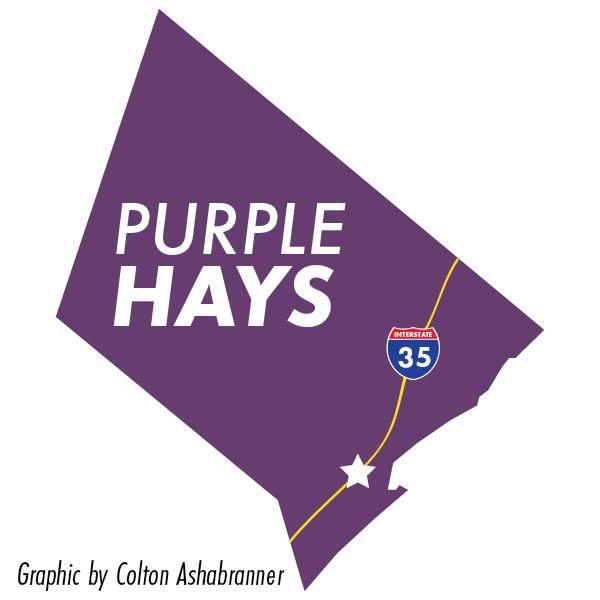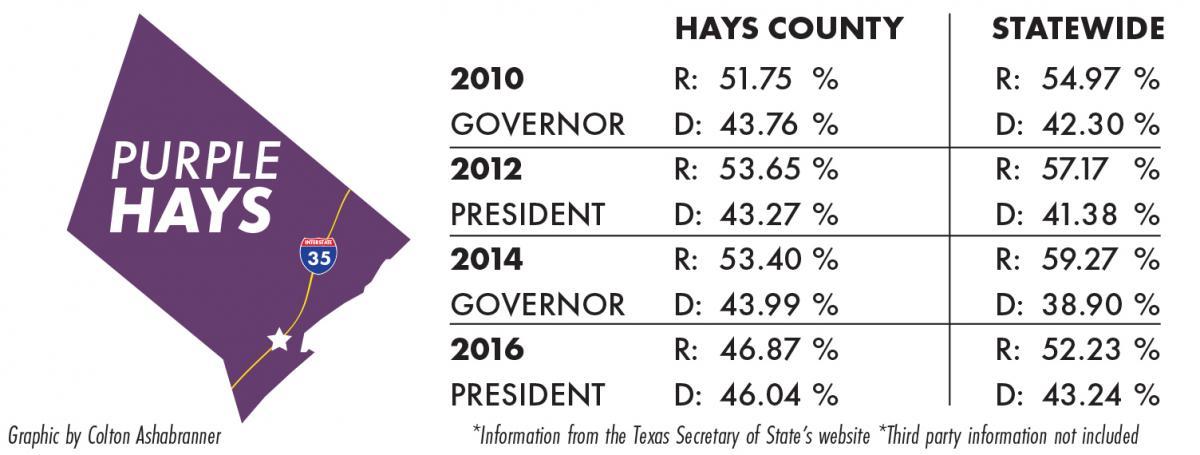
Purple Hays: A look at changing voting patterns
Record voter registration levels in the state have made headlines recently. The Houston Chronicle reported that Texas has added half a million registered voters since the March primaries. Voter registration in major metropolitan counties has increased 3 percent since March, the Chronicle reported, and Hays County has seen the largest voter increase in the state percentage-wise, with an 8 percent growth in registered voters since March.
However, voter turnout does not necessarily mirror voter registration, according to Donald Inbody, lecturer in the Department of Political Science at Texas State University.
“There is no evidence that higher registration translates into higher turnout in general,” Inbody said. “... That’s what the science tells us; that’s what the data tells us from years of looking at this.”
However, Hays County Elections Administrator Jennifer Anderson is still expecting higher turnout than the typical midterm election.
“My gut is that this will be a very busy midterm election for both sides, and that the turnout is likely to match a presidential election, with higher numbers than we’ve seen in previous midterm elections,” she said.
Anderson noted that in the 2012 presidential election, voter turnout in Hays County was 60 percent. Turnout was 63 percent for the 2016 presidential election. In contrast, turnout for the 2014 midterm election was a mere 38 percent.

The spectrum from red to blue
Texas is known as a solidly red — Republican — state, but there are pockets of blue — counties that favor Democratic candidates — to be found, mostly in the major metropolitan areas. And Hays County?
“It’s a pretty purple county,” Inbody said, adding that he had discussed the county’s voting patterns with the previous county elections administrator, Joyce Cowan.
Inbody said that most voters in Texas vote straight ticket, a practice which tends to favor Republican candidates even at the local level.
As a result, he said, “The county probably leans Republican.”
“Hays has historically voted red; however, 2016 showed an increase in blue votes,” Anderson said.
Figures from the Texas Secretary of State’s Office show that, at least when voting for governors and presidents, since 2010 Hays has leaned toward Republican candidates, but not by a large percentage — and typically, Hays County has been less “red” than the state overall. In recent years, the largest gaps between Democratic and Republican candidates came in the 2012 presidential election and the 2014 gubernatorial election, where there was about a 10 point difference — 53 to 43 percent.
In 2016, as Anderson noted, that gap closed. Hays County voters casting ballots in the presidential election were split nearly down the middle, with 46.87 voting Republican and 46.04 percent voting Democratic. About 600 votes separated the Trump/Pence ticket and the Clinton/Kaine ticket among Hays County voters.
Looking ahead
Though voter registration is at a record high and voter turnout could be higher than usual for a midterm election, Inbody said the notion that higher voter turnout favors Democratic candidates does not necessarily hold true.
“That’s a conventional wisdom that we’re pretty convinced is not accurate,” he said, noting that the correlation might be found in some local precincts.
Inbody also predicts that the U.S. Senate race between Beto O’Rourke and Ted Cruz, which has drawn national attention, will not necessarily go in O’Rourke’s favor.
“My guess is that Cruz will win,” he said. “The question is how well will Beto do.”
If O’Rourke can get as much as 40-42 percent of the vote, Inbody said, “then something has changed in Texas politics.”
However, Inbody noted that the results have a lot to do with the quality of candidates.
“It’s not impossible that he will win,” he said of O’Rourke.
Inbody also emphasized that voters’ concerns differ from the national and state level to the local level. Local politics tend to be less partisan — although Texans’ habit of straight-ticket voting can be a disadvantage for local candidates affiliated with a political party. At the higher levels, Inbody said, politics is more ideological, but local elections tend to focus more on the practical.
“The more local you get with elections, the more pragmatic it is,” he said. “When it comes to local elections, the issues are things like the pothole in front of my house hasn’t been fixed in a year and a half.”
Early voting for the Nov. 6 midterm election — in which both ideology and potholes are factors — begins Oct. 22.
Voting information can be found at the Hays County Elections Office general election page and at the League of Women Voters’ Vote 411 website.











